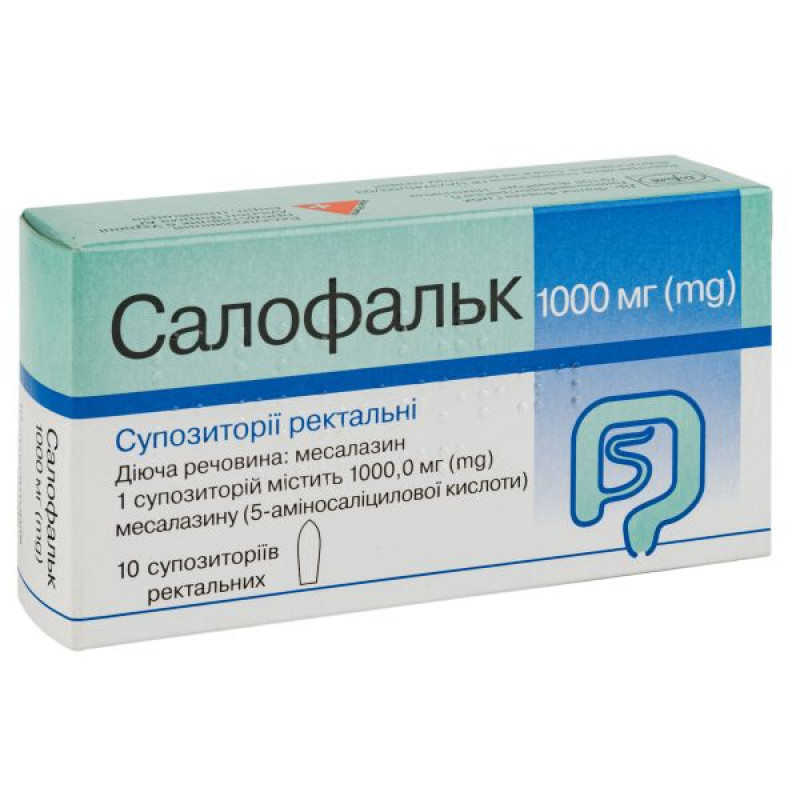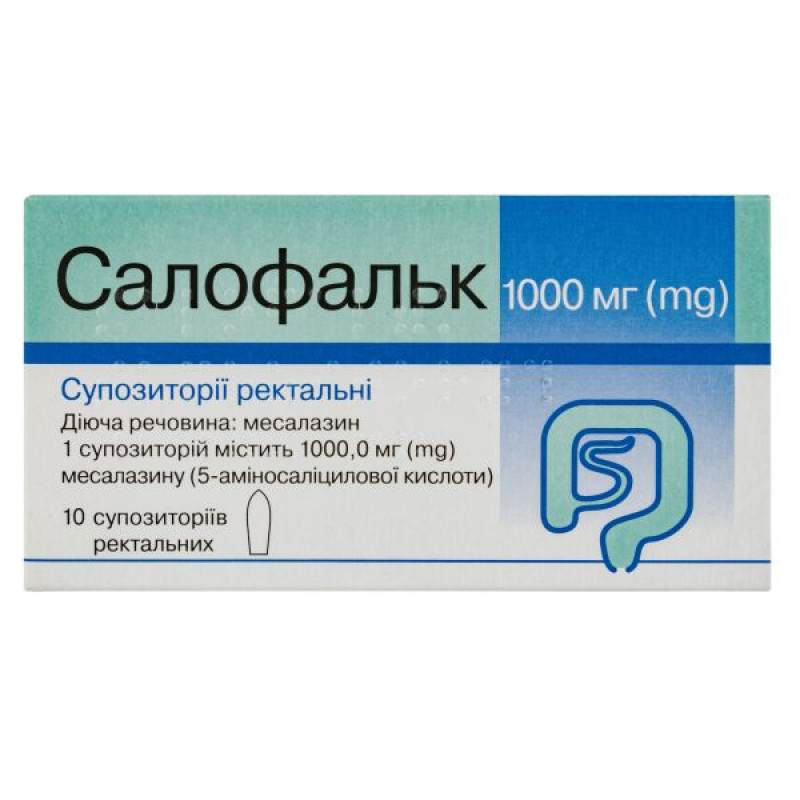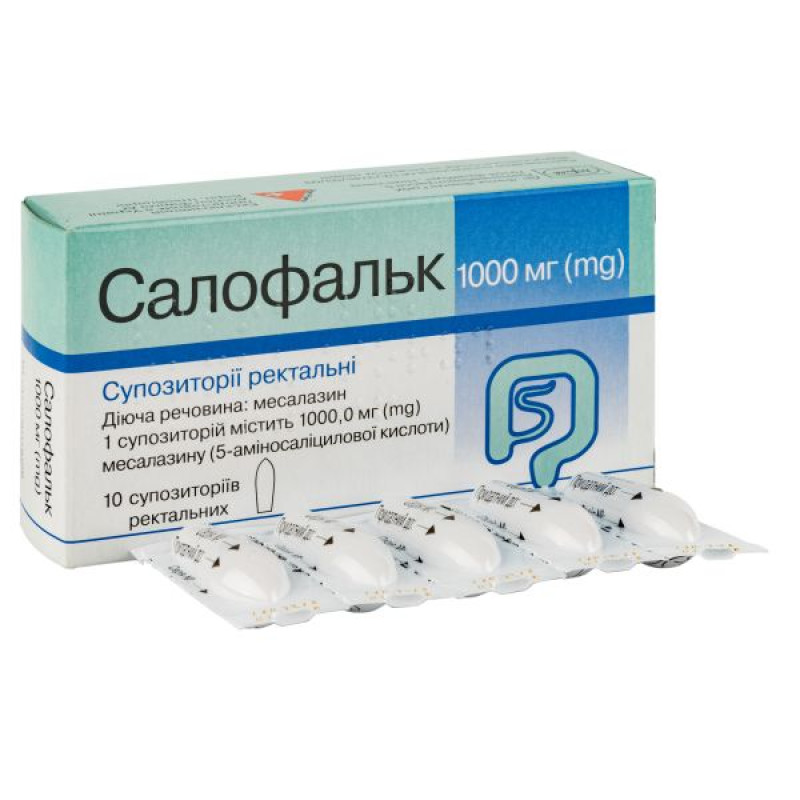Salofalk rectal suppositories 1000 mg strip No. 10

Instructions for use Salofalk rectal suppositories 1000 mg strip No. 10
Composition
active ingredient: mesalazine;
1 suppository contains 1000 mg of mesalazine (5-aminosalicylic acid);
excipient: solid fat
Dosage form
Rectal suppositories.
Main physicochemical properties: suppositories of light beige color, torpedo-shaped, with an even, smooth and undamaged surface. During storage, a white coating may form on the surface due to recrystallization of solid fats.
Pharmacotherapeutic group
Gastrointestinal tract and metabolism. Antidiarrheals, intestinal anti-inflammatory/antimicrobial drugs. Intestinal anti-inflammatory drugs. Aminosalicylic acid and similar agents. Mesalazine.
ATX code A07ES02.
Pharmacological properties
Pharmacodynamics
Mechanism of action
The mechanism of anti-inflammatory action is unknown. In vitro studies suggest that inhibition of lipoxygenase may play a role.
An effect on prostaglandin concentrations in the intestinal mucosa has also been demonstrated. Mesalazine (5-aminosalicylic acid/5-ASA) may also act as a scavenger of reactive oxygen species.
Pharmacodynamic effect
Mesalazine, when administered rectally, acts predominantly locally on the mucosa and submucosa of the intestines. The clinical efficacy and safety of Salofalk 1000 mg suppositories were tested in phase III multicenter clinical trials involving 403 patients with endoscopy- and histologically confirmed ulcerative proctitis of low to moderate activity. The mean disease activity index (DAI) at the beginning of the studies was 6.2 ± 1.5 (range: 3–10). Patients were randomized to treatment with one Salofalk 1000 mg suppository (group “1000×1”) or 3 Salofalk 500 mg suppositories daily (group “500×3”) for 6 weeks. The primary efficacy endpoint was clinical remission, defined as an IAS < 4 at the last visit or drug withdrawal. At the final analysis, 87.9% of patients in the 1000×1 group and 90.7% in the 500×3 group were in clinical remission (intention-to-treat analysis: 1000×1 group: 84.0%; 500×3 group: 84.7%). The mean change from baseline in IAS was -4.7 in both groups. No serious drug-related adverse events were observed.
Pharmacokinetics
General properties of mesalazine
Absorption
Absorption of mesalazine is highest in the proximal part of the intestine and lowest in its distal part.
Biotransformation
Mesalazine is metabolized both presystemically in the intestinal mucosa and in the liver to the pharmacologically inactive N-acetyl-5-aminosalicylic acid (N-Acetyl-5-ASA). Acetylation is apparently independent of the acetylation phenotype of the patient. Some acetylation also occurs by the action of bacteria in the large intestine. The protein binding of mesalazine and N-Acetyl-5-ASA is 43% and 78%, respectively.
Excretion
Mesalazine and its metabolite N-Ac-5-ASA are excreted in the faeces (major part), renally (varying between 20% and 50%, depending on the type of administration, pharmaceutical form and route of release of mesalazine) and biliary (minor part). Renal excretion occurs mainly in the form of N-Ac-5-ASA. About 1% of the total orally administered dose of mesalazine is excreted in breast milk, mainly in the form of N-Ac-5-ASA.
Features of the drug Salofalk, rectal suppositories 1000 mg
Distribution
Scintigraphic studies with technetium-labeled Salofalk 500 mg suppositories showed a peak distribution of the suppository, which melted at body temperature, after 2–3 hours. Distribution was limited primarily to the rectum and rectosigmoid colon. Salofalk 1000 mg suppositories are therefore particularly suitable for the treatment of proctitis (ulcerative colitis of the rectum).
Absorption
In healthy subjects, the mean plasma concentration of 5-ASA after a single rectal administration of 1000 mg mesalazine (Salofalk 1000 mg suppository) was 192±125 ng/ml (range 19–557 ng/ml); the concentration of the main metabolite, N-acetyl-5-ASA, was 402±211 ng/ml (range 57–1070 ng/ml). The maximum plasma concentration of 5-ASA was reached after 7.1±4.9 h (range 0.3–24 h).
Breeding
In healthy subjects, approximately 14% of the administered dose of 5-ASA is excreted in the urine within 48 hours after a single rectal administration of 1000 mg mesalazine (one Salofalk 1000 mg suppository).
Indication
Treatment of exacerbations of ulcerative colitis limited to the rectum (ulcerative proctitis).
Contraindication
Hypersensitivity to mesalazine, to any of the components of the drug or to salicylates, gastric and duodenal ulcer in the acute stage, severe hepatic and/or renal failure, hemorrhagic diathesis.
Interaction with other medicinal products and other types of interactions
In the case of simultaneous treatment with Salofalk and azathioprine, 6-mercaptopurine or thioguanine, the possible increase in the myelosuppressive effect of azathioprine, 6-mercaptopurine or thioguanine should be taken into account.
There is evidence that mesalazine may reduce the anticoagulant effect of warfarin.
Application features
At the discretion of the physician, blood tests (complete blood count; liver function parameters such as ALT or AST; serum creatinine) and urine tests (test strips, sediment) should be performed during and after treatment. It is recommended that tests be performed approximately 14 days after the start of treatment and then 2–3 times at 4-week intervals.
If the test results are normal, routine checks can be done every 3 months, but if other additional symptoms appear, tests must be done urgently.
It should be used with caution in patients with impaired liver function.
Salofalk 1000 mg suppositories should not be used in patients with impaired renal function. If renal function deteriorates during treatment, mesalazine-induced renal toxicity should be considered.
Cases of nephrolithiasis, including the formation of stones with a 100% mesalazine content, have been reported with the use of mesalazine. Adequate fluid intake is recommended during treatment.
Patients with lung diseases, in particular asthma, should be under the supervision of a physician during the course of treatment with Salofalk 1000 mg suppositories.
Adverse severe skin reactions
Severe skin adverse reactions, including Stevens-Johnson syndrome (SJS) and toxic epidermal necrolysis (TEN), have been reported in association with mesalazine treatment. Mesalazine should be discontinued at the first appearance of signs and symptoms of severe skin reactions, such as skin rash, mucosal lesions or any other signs of hypersensitivity.
Patients who have hypersensitivity reactions to drugs containing sulfasalazine should be under the supervision of a physician from the very beginning of the course of treatment with Salofalk 1000 mg suppositories. If acute symptoms of intolerance appear, such as cramps, acute abdominal pain, fever, severe headache and rash, therapy should be discontinued immediately.
Use during pregnancy or breastfeeding
Pregnancy
There are no adequate data from the use of Salofalk 1000 mg suppositories in pregnant women. However, data on a limited number of exposed pregnancies indicate no adverse effects of mesalazine on pregnancy or on the health of the fetus and/or newborn. No other epidemiological data are available for this product. Only one case of renal failure in the newborn has been reported following prolonged use of mesalazine at high doses (2-4 g orally) during pregnancy.
Animal studies with oral administration of mesalazine do not indicate direct or indirect harmful effects with respect to pregnancy, embryonal/fetal development, parturition or postnatal development.
Salofalk 1000 mg suppositories should be used during pregnancy only if the expected benefit outweighs the possible risk.
Lactation
N-acetyl-5-aminosalicylic acid and to a lesser extent mesalazine are excreted in breast milk. There is currently only limited experience of use in women during breastfeeding. Hypersensitivity reactions in the breastfed infant, such as diarrhoea, cannot be excluded. Therefore, Salofalk 1000 mg suppositories should be used during breastfeeding only if the expected benefit to the mother outweighs the possible risk to the infant. If diarrhoea develops in the breastfed infant, breastfeeding should be discontinued.
Ability to influence reaction speed when driving vehicles or other mechanisms
The use of Salofalk, rectal suppositories 1000 mg, has no or only minor influence on the ability to drive or operate machinery.
Method of administration and doses
This medicine is for rectal use only.
It is advisable to use Salofalk 1000 mg suppositories in the evening before bedtime.
The desired therapeutic result can be achieved only with regular and constant use of the drug Salofalk, rectal suppositories 1000 mg.
The duration of use is determined by the doctor.
Adults and elderly patients
One Salofalk 1000 mg suppository is administered rectally once a day (equivalent to 1000 mg of mesalazine per day).
Children
There is insufficient data on the use of this medicine in children.
Overdose
There are reports of rare cases of overdose (e.g. intentional suicide by taking a high oral dose of mesalazine) which do not indicate renal or hepatic toxicity. There is no specific antidote, treatment should be symptomatic and supportive.
Side effects
In clinical trials involving 248 participants, approximately 3% of patients experienced adverse reactions with Salofalk 1000 mg rectal suppositories. The most common adverse reactions were headache, approximately 0.8%, and gastrointestinal reactions (constipation, approximately 0.8%; nausea, vomiting, and abdominal pain, each 0.4% of the time).
The following adverse reactions have been observed when taking mesalazine:
| Organ system | Frequency according to MedDRA | ||
rare (≥ 1/10,000; < 1/1,000) | very rare (< 1/10,000) | Frequency unknown (cannot be estimated from available data) | |
| Blood system and lymphatic system | Changes in blood composition (aplastic anemia, agranulocytosis, pancytopenia, neutropenia, leukopenia, thrombocytopenia) | ||
| Nervous system | Headache, dizziness | Peripheral neuropathy | |
| Cardiovascular system | Myocarditis, pericarditis | ||
| Respiratory, thoracic and mediastinal organs | Allergic and fibrotic pulmonary reactions (including dyspnea, cough, bronchospasm, alveolitis, pulmonary eosinophilia, pulmonary infiltration, pneumonitis) | ||
| Gastrointestinal tract | Abdominal pain, diarrhea, flatulence, nausea and vomiting | Acute pancreatitis | |
| Kidneys and urinary organs | Renal impairment, including acute and chronic interstitial nephritis and renal failure | Nephrolithiasis* | |
| Leather and its derivatives | Increased skin sensitivity to sunlight and ultraviolet rays (photosensitivity). | Alopecia | Stevens-Johnson syndrome (SJS), toxic epidermal necrolysis (TEN) |
| Musculoskeletal system and connective tissues | Myalgia, arthralgia, cramps | ||
| Immune system | Hypersensitivity reactions, including allergic rashes, drug fever, lupus erythematosus syndrome, pancolitis, angioedema | ||
| Liver and gallbladder | Changes in liver function tests (increased transaminases and bile stasis parameters), hepatitis, cholestatic hepatitis, liver failure | ||
| Reproductive system | Oligospermia (reversible) | ||
*For more detailed information, see the "Application Features" section.
Severe skin adverse reactions, including Stevens-Johnson syndrome (SJS) and toxic epidermal necrolysis (TEN), have been reported in association with mesalazine treatment (see section 4.4).
Photosensitivity
There have been reports of severe reactions in patients with skin conditions such as atopic dermatitis and atopic eczema.
Reporting of suspected adverse reactions
Reporting suspected adverse reactions after a medicinal product has been authorised is very important. This allows the benefit/risk balance of the medicinal product to be continuously monitored. Healthcare professionals are asked to report any suspected adverse reactions via
Bundesinstitut für Arzneimittel und Medizinprodukte
(Federal Institute of Medicines and Medical Devices)
Pharmacovigilance Department
Kurt-Georg-Kiesinger-Allee 3
53175 Bonn
www.bfarm.d
Expiration date
3 years.
Do not use after the expiration date indicated on the package.
Storage conditions
Keep out of the reach of children. Store at a temperature not exceeding 30 ° C. Store in the original package in order to protect from light.
Packaging
5 suppositories in a strip, 2 or 6 strips in a cardboard box.
Vacation category
According to the recipe.
Producer
Dr. Falk Pharma GmbH/Dr. Falk Pharma GmbH.
Address
Leinenweberstrasse 5, 79108 Freiburg, Germany.
There are no reviews for this product.
There are no reviews for this product, be the first to leave your review.
No questions about this product, be the first and ask your question.





